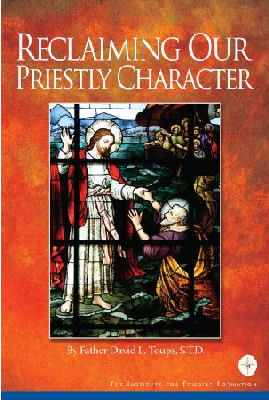
|
Posted May 29, 2008
Book: Reclaiming Our Priestly Character Author: Father David L. Toups The Institute for Priestly Formation. Creighton, NE. 2008. Pp. 216 An Excerpt from the Preface: Being a child of God and serving Him is a joy to those who faithfully and lovingly live their vocation. This is true for all Christians, but for the priest, the ramification of not doing so are catastrophic. As Blessed Columba Marmion wrote, “There could be no more fatal error for the priest than to underestimate the sacerdotal dignity. He must, on the contrary, have a very high conception of it.”
The priest must know who he is in order that he might act and serve in a manner appropriate to his state in life agere sequitur esse — “doing follows being.” An integration of priestly identity and the call to love and serve is the call of today’s priests. Now is the time for us to reclaim the gift received at ordination and joyfully serve the Bride of Christ so as to witness to the beauty of our vocation. We need not be afraid or ashamed of being priests in the world today. The Lord and His Church need us to be who we are. By renewing our understanding of the priestly character, we are not saying that we are better than the lay faithful (and certainly not guaranteeing that we are holier), but that we are different by virtue of ordination. (Cf. Lumen Gentium 10). The more a priest recognizes the “gift received through the laying on of hands” (2 Timothy 1:6) the more he can allow the priestly character to animate the whole of his life of love and service to the people of God; this character is a dynamism for pastoral charity and holiness. We do the Church and ourselves a disservice when we deny the ontological reality of who we are — either theologically or functionally. Let us glorify God and edify (literally buildup) the Body of Christ by living with great enthusiasm the ministerial priesthood of Jesus Christ the great High Priest. An Excerpt from the Book: Following the 1990 Synod of Bishops, Pope John Paul II released the Post-Synodal Apostolic Exhortation Pastores Dabo Vobis. John Paul II wrote: “Knowledge of the nature and mission of the ministerial priesthood is an essential presupposition and at the same time the surest guide and incentive toward the development of pastoral activities in the Church for fostering and discerning vocations to the priesthood and training those called to the ordained ministry” (PDV II). Mature knowledge of who one is and an objective knowledge of the priesthood was an issues of extreme importance in the mind of the late Holy Father. One theologian noted: The truth about the priest is the object of what we may call priestly self-knowledge. This has to do with the knowledge of the priest of and about himself., something of which, we believe, is what John Paul II tries to inculcate in the minds of priests. His overriding concern is for priests to have a crystal clear knowledge of who they are, what they are meant to do, and the reason why they should do it. A dubious perception of oneself as a priest leads to a dubious exercise of priestly ministry. In the course of time, it inevitably leads the priest to doubt his very existence [or ontological being]. He starts to lose meaning in what he does — a meaning which can only be derived from the strength of his conviction about his priestly identity, based on the correct perception of himself as God’s minister.” Table of Contents Chapter 1 Reclaiming Character Chapter II Post-Conciliar Confusion Chapter III The Foundation of the Priestly Life |
|
